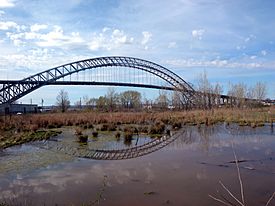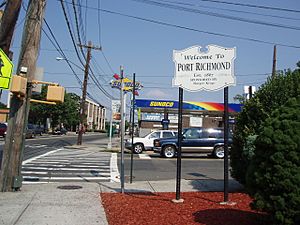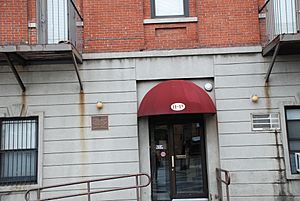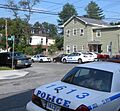Port Richmond, Staten Island facts for kids
Quick facts for kids
Port Richmond
|
|
|---|---|
|
Neighborhood of Staten Island
|
|
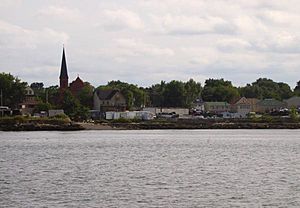
Port Richmond, seen from Bayonne, New Jersey across the Kill Van Kull.
|
|
| Country | |
| State | |
| City | |
| Borough | Staten Island |
| Community District | Staten Island 1 |
| Area | |
| • Total | 2.73 km2 (1.055 sq mi) |
| Population
(2011)
|
|
| • Total | 18,516 |
| • Density | 6,776/km2 (17,551/sq mi) |
| Includes West New Brighton | |
| Economics | |
| • Median income | $51,135 |
| ZIP Code |
10302
|
| Area code | 718, 347, 929, and 917 |
Port Richmond is a neighborhood on the North Shore of Staten Island. This is a borough of New York City. Port Richmond is bordered by the Kill van Kull to the north and Bayonne Bridge to the west. It is next to West New Brighton on the east. To the south are Westerleigh and Forest Avenue. On the west are Elm Park and Mariners Harbor.
Port Richmond used to be its own village. It is one of the oldest neighborhoods on Staten Island. In the 1800s, it was a major center for transportation and industry. Today, it is mostly a residential area. Many small businesses have opened there since the late 1900s.
Port Richmond is part of Staten Island Community District 1. Its ZIP Code is 10302. The New York City Police Department's 121st Precinct patrols the area.
Contents
History of Port Richmond
Early Days and First Settlements
The first European to see Staten Island was Giovanni da Verrazzano in 1524. In 1609, Henry Hudson started Dutch trade in the area. He named the island Staaten Eylandt after the Dutch parliament. A mixed Dutch and French settlement began in New Dorp in the mid-1600s.
Settlers created a cemetery in Port Richmond. It was used until 1696 for people living in northern Staten Island. The community of Port Richmond grew around this cemetery. The Dutch Reform Church was built there in the early 1700s. The current church building, with columns, was built in 1824. This was after a fire destroyed the first one. From these Dutch beginnings, Port Richmond became a busy industrial and transportation center by the water. The village officially became Port Richmond in 1866.
Port Richmond has had many names over the years. In the late 1600s, it was called "The Burial Place." Other names suggested were Bristol, New Bristol, and Irvington. But "Port Richmond" was chosen in 1866. Reverend Dr. James Brownlee of the Dutch Reformed Church gave it this name.
In 1700, the area was known for a cemetery of the Reformed Church on Staten Island. This cemetery was near the current Port Richmond Avenue. Later, it became a transfer point for ferries from New York City to New Brunswick, New Jersey. A ferry landing was built for a route across the Kill Van Kull to Bergen Point (now Bayonne, New Jersey). The Bayonne Bridge was built in 1931. Ferry service continued until 1962.
The 1800s in Port Richmond
Port Richmond's spot on the Kill Van Kull made it a great place for ferries to New Jersey. It was a transfer port for goods and people traveling by boat. This spot is the closest part of Staten Island to Port Elizabeth, New Jersey. It was once called Mersereau's Point. Many ferries operated from here, like Dacosta's and Decker's. Ferries ran until shortly after the Bayonne Bridge was built in 1931. The area also became an important stop on a coach route between New York City and Philadelphia. Port Richmond Avenue has been known by names like Church Road and Richmond Avenue.
Cornelius "Commodore" Vanderbilt, a famous railway leader, was born here in 1794. In 1836, former Vice President Aaron Burr died in Port Richmond. He passed away at the St. James Hotel, which used to be on Richmond Terrace.
In the early 1800s, the area was an overnight stop for coaches. In 1836, a public park was built. In the mid-1800s, people from Ireland and Germany started moving here. One industry was the only whale oil processing plant on Staten Island. It was later replaced by a linseed oil plant. Other businesses included lumber and coal yards. Because oyster harvesting was big in New York Harbor, many successful oyster boat captains built large homes. These homes were on Richmond Terrace facing the Kill van Kull in the 1840s and 1850s.
In 1883, Port Richmond was seen as a great village:
The general appearance of Port Richmond is inviting and pleasing. The streets are wide, well-macadamized and smooth; the side walks well paved and generally shaded by trees of large growth. The business blocks are substantial and the dwellings range from pretentious mansions to quiet cottage
In 1866, the neighborhood became Port Richmond. In the 1880s, the Staten Island Railway built a North Shore branch. It had a stop in the village on Richmond Avenue, which was a main shopping area. In the 1870s, St. Philip's Baptist Church was formed. It is the oldest Black Baptist church on the island. The church is still at 77 Bennett Street. Next to it is the Port Richmond Library, built with money from Andrew Carnegie in 1902. In the early 1900s, many Italian, Polish, Norwegian, and Swedish immigrants moved to the neighborhood. Temple Emanu-El built its domed, Classical building in 1907.
Port Richmond in the 1900s
The neighborhood faced a tough economic time in the late 1900s. This was partly because development moved to the center of the island. This happened after the Verrazzano-Narrows Bridge and Staten Island Mall were built. The North Shore Branch of the Staten Island Railway ran through Port Richmond. It was mainly a freight railroad. It briefly offered passenger service in 1925 and 1926. This service was stopped because the boat ride was slower. During World War II, some trains moved troops. This branch closed in 1953. It left behind old tracks and the Port Richmond station.
Community and People
In 2010, Port Richmond had 20,191 people. This was an increase of 2,149 people from 2000. The neighborhood covers about 840 acres.
Port Richmond is a diverse neighborhood. In 2010, 40.2% of residents were White. 16.8% were African American, and 3.9% were Asian. People of Hispanic or Latino background made up 36.6% of the population. The 10302 ZIP code, which includes most of Port Richmond, has the highest percentage of Hispanic people on Staten Island, at 41.3%. Within the Hispanic population, Mexicans are the largest group, making up about 20% of the ZIP code's population.
The northern part of Port Richmond, near Richmond Terrace, has the largest Black and Latino populations. The southeastern part, sometimes called "Port Richmond Center," has the largest percentage of White residents.
Community Efforts and Support
The community has seen changes over the years. Starting in the late 1980s, many Mexican immigrants moved into the northern parts of Port Richmond. They helped open new businesses along Port Richmond Avenue. This street quickly became a center for Latino culture on Staten Island.
Sometimes, there have been challenges between long-time residents and newcomers. However, many groups have formed to help the community work together. These groups aim to build understanding and support for everyone.
Some of these groups include:
- Northfield Community Local Development Corp.
- Port Richmond Anti-Violence Task Force
- Make the Road New York
- Eye Openers Youth Against Violence
- Project Hospitality
- El Centro de Hospitalidad (Latino Civic Association of Staten Island)
- Port Richmond Improvement Association
- Community Health Action of Staten Island (formerly Staten Island Aids Task Force)/Port Richmond Wellness Center
- Community Health Center of Richmond
- Amazing Grace Interfaith Church
- Community By Community
- Labyrinth Arts Collective, Inc.
Wagner College's Partnership Initiative
In 2008, Wagner College started a special plan with Port Richmond. The college and seven community groups worked together for five years. Their goal was to improve life for residents. They focused on things like health care, youth well-being, and educational opportunities. Students from Wagner College helped with volunteer activities. They reported on their progress as part of their classes. The aim was to make big improvements in the neighborhood.
Former president Bill Clinton praised this initiative in 2009. He spoke about it at The Clinton Global Initiative University (CGI U) Meeting. This shows how important and successful the partnership was.
Safety and Services
Fire Safety
The New York City Fire Department (FDNY) serves Port Richmond. Engine Co. 157/Ladder Co. 80 is located at 1573 Castleton Avenue.
Post Office
Port Richmond is in ZIP Code 10302. The United States Postal Service has a post office called Port Richmond Station at 364 Port Richmond Avenue.
Education in Port Richmond
Port Richmond and the North Shore have a lower rate of college-educated residents compared to the rest of New York City. In 2018, 37% of adults aged 25 and older had a college education or higher. However, 15% had less than a high school education.
Students in Port Richmond and the North Shore have shown good progress in math. The percentage of students doing well in math went from 49% in 2000 to 65% in 2011. Reading achievement stayed about the same.
Schools in the Neighborhood
The New York City Department of Education runs these elementary schools in Port Richmond:
- PS 19 The Curtis School (grades PK-5)
- PS 20 Port Richmond (grades K-5)
Port Richmond High School is in Port Richmond. Its current building was built in 1993, but the school first opened in 1927. It has about 2,700 students. It is known as one of the best high schools on Staten Island. The school is known for its excellence in sports and academics. Newsweek magazine has often listed Port Richmond High School among its "Best High Schools." The local middle school is Markham Intermediate School.
The Roman Catholic Archdiocese of New York used to operate St. Roch Parish School, but it closed in 2011.
Library Services
The New York Public Library (NYPL) has a Port Richmond branch at 75 Bennett Street. People wanted a library here as early as 1833. Various private library groups operated in the 1800s. The current Port Richmond branch building was built in 1905. It is a Carnegie library, meaning it was built with funds from Andrew Carnegie. An auditorium was added in 1939, and the Children's Room was updated in 2008.
Getting Around Port Richmond
Port Richmond has the Castleton Bus Depot. Many local and express buses serve the area. These include the S40, S44, S46, S48, S53, S54, S57, S59, S66 local buses. There are also S89, S90, S94, S96, S98 limited-stop buses. For longer trips, SIM3, SIM3C, SIM30, SIM35 express buses are available. The abandoned North Shore Branch of the Staten Island Railway runs through Port Richmond. The old station building is still there.
Historic Places to See
Ritz Theater
The Ritz Theater is at Port Richmond Avenue and Anderson Avenue. It used to be a movie theater and vaudeville place. Now, it's a home improvement store. It once hosted famous rock and roll and show business stars. It was built in 1924 and had 2,126 seats. It was one of New York's best vaudeville houses. The theater's famous murals are still on the walls.
Old PS 20
Old PS 20 is now mostly a retirement community. It is one of the few remaining school buildings from the 1800s on Staten Island. A school has been on this site since 1842. The building standing today was built in 1891. An addition was added in 1898. The building has a mix of styles, including Romanesque Revival and neo-Classical. The bell tower on Old PS 20 is special. It was the first school building to have such an impressive tower. It is the last one remaining. Old PS 20 was named a Landmark Site in 1988.
121 Heberton Avenue
This is a 2½-story wooden building. It is on the east side of Veteran's Park. This area was once very fashionable. 121 Heberton was built around 1859-61. It is a rare example of a picturesque villa in the Rustic style in New York City. The house was first owned by Captain John J. Housman, a successful oysterman. It is still used as a home today. Recent updates have kept its unique historic look. The 121 Heberton Avenue House was named a Landmark Site in 2002.
Bodine Creek
Bodine Creek is a short walk from The New York Public Library. It has had many names, like Palmer's Run. Near Bodine Creek was Bodine's Pond. Industries used this pond for years. The Richmond County Water Company used to get water from here. The edges of the pond can still be seen today.
Port Richmond Hotel
The Port Richmond Hotel is a large building facing the Bayonne ferry terminal. It was once the elegant St. James Hotel. The St. James Hotel was built in 1787 and torn down in 1945. A plaque on the Griffith Block building shows that it was the last home of Aaron Burr. He was the third Vice President of the United States. He died there on September 14, 1836.
Reformed Protestant Dutch Church and Burial Ground
This church was built in 1845 in the Greek Revival style. It is the third church on this site. It was listed on the National Register of Historic Places in 2005. The first church, a wooden building, was built in 1714. It was destroyed by the British during the American Revolution. The land for the original church was given by Governor Hunter in 1714. The original license is still kept today. The grounds also honor five brothers from Staten Island who served in the Revolutionary War. They were the Mersereau Brothers.
Notable People from Port Richmond
- Aaron Burr: U.S. Vice President, died in Port Richmond.
- Carmine Giovinazzo: Actor in Black Hawk Down and CSI:NY, born in Port Richmond.
- John Henry Lake: 1900 Olympic bronze medal cyclist.
- Anning S. Prall: Born in Port Richmond in 1870, U.S. Representative, and Chair of the Federal Communications Commission.
- Jacob Tyson: Born in Richmond County in 1773, U.S. Representative, and New York State Senator. He is buried in the Dutch Reformed Churchyard.
Images for kids



